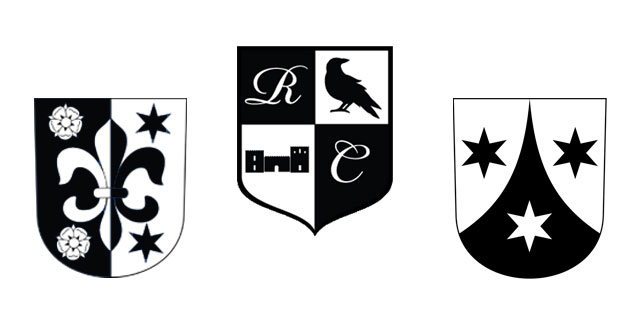
Legends & Lore – Coats of Arms
In Legends and Lore we feature interesting historical and mythological tidbits associated with Ravenwood Castle. This week’s Legends and Lore is written by our former Assistant Innkeeper, Abby Kutscher.
No reputable castle would be complete without a coat of arms or crest. The words are often used interchangeably, although a crest is actually just a single part of a coat of arms. The coat of arms refers to the entirety of the crest, helmet, mantling, supporters, and shield. Either way, both a coat of arms and a crest are an insignia used to identify a particular family or group.
The crest for Ravenwood Castle is a depiction of both the silhouette of the castle itself, as well as our mascot – Ralph the Raven. For us, the crest makes for a cool logo on our website and our gift shop items. Historically, there is actually a lot of significance attributed to a coat of arms.
Starting in the 11th century, coats of arms were used on the uniforms of soldiers to identify both the individual and the branch of the military that he was associated with. Two centuries later, the coat of arms had become a status symbol for the upper echelon of Europe. There were even laws put into place in order to regulate who had the right to bear a family crest. The study of coats of arms is called “heraldry” in reference to the heralds who regulated their use.
In the majority of Europe, excluding Germany, coats of arms were only allowed to be used by the aristocracy. Eventually, the use spread to clergymen, universities, and towns. The use of crests/coats of arms is still widespread throughout most of Europe.
Traditionally, a coat of arms was considered legal property and was passed from father to son over the generations. Generally, the firstborn son inherited the family crest after the death of the father. After a marriage, sometimes the two families would combine their crests to form an entirely new hybrid version. In some regions, women were allowed to have their own crests as well. Typically, a man’s was square-shaped and a woman’s was round. Different colors and shapes on a coat of arms act as symbols. For example, the color orange stands for ambition and a symbol such as a stag can signify that the family members are hunters.
However you look at it, the study of crests and coats of arms is pretty fascinating. On your next visit to Ravenwood Castle be sure to spend some time finding all of the coats of arms around the grounds. Perhaps it will inspire you to do some research into your own family crest or coat of arms!


 Quoth the Raven
Quoth the Raven